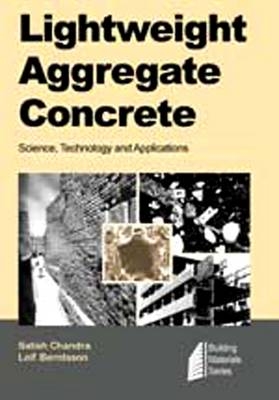
Lightweight Aggregate Concrete
Seiten
2002
William Andrew Publishing (Verlag)
978-0-8155-1486-2 (ISBN)
William Andrew Publishing (Verlag)
978-0-8155-1486-2 (ISBN)
- Titel ist leider vergriffen;
keine Neuauflage - Artikel merken
Presents a picture of lightweight aggregate concrete, from the historical background, aggregate production, proportioning and production of concrete, to applications in structures. This book describes the physical properties and chemical durability. It also covers fire resistance, an important aspect of the safety of the structure.
In spite of the increasing use and demand for lightweight aggregate concrete (LWAC), there is still a lack of adequate explanations to understand the mechanisms responsible for the strength and durability properties of LWAC. This book is written to give an overall picture of LWAC, from the historical background, aggregate production, proportioning and production of concrete, to applications in structures. Physical properties and chemical durability are described in detail. The physical properties include density, strength, shrinkage, and elasticity. Chemical durability includes resistance to acids, chloride ingress, carbonation, and freeze-thaw resistance. Fire resistance is also included, which is seldom considered, but is a very important aspect of the safety of the structure. Microstructure development and its relation to the durability properties of LWAC generally are not highlighted in the literature. The development of bonds, the microstructure with different binder systems, and different types of lightweight aggregates are explained. They show how lightweight aggregate concrete differs from normal weight concrete. The chapters on chloride ingress and freeze-thaw resistance are detailed because of the use of LWAC in offshore construction. The economical aspects of using LWAC are also reviewed. Emphasis is placed on the fact that although the cost of LWAC is high, the total cost of construction has to be considered, including the cost of transport, reinforcement, etc. When these are considered then LWAC becomes cheaper and attractive. The life cycle cost of the concrete is another consideration for calculating long-term savings on maintenance costs.
In spite of the increasing use and demand for lightweight aggregate concrete (LWAC), there is still a lack of adequate explanations to understand the mechanisms responsible for the strength and durability properties of LWAC. This book is written to give an overall picture of LWAC, from the historical background, aggregate production, proportioning and production of concrete, to applications in structures. Physical properties and chemical durability are described in detail. The physical properties include density, strength, shrinkage, and elasticity. Chemical durability includes resistance to acids, chloride ingress, carbonation, and freeze-thaw resistance. Fire resistance is also included, which is seldom considered, but is a very important aspect of the safety of the structure. Microstructure development and its relation to the durability properties of LWAC generally are not highlighted in the literature. The development of bonds, the microstructure with different binder systems, and different types of lightweight aggregates are explained. They show how lightweight aggregate concrete differs from normal weight concrete. The chapters on chloride ingress and freeze-thaw resistance are detailed because of the use of LWAC in offshore construction. The economical aspects of using LWAC are also reviewed. Emphasis is placed on the fact that although the cost of LWAC is high, the total cost of construction has to be considered, including the cost of transport, reinforcement, etc. When these are considered then LWAC becomes cheaper and attractive. The life cycle cost of the concrete is another consideration for calculating long-term savings on maintenance costs.
Historical Background of Lighweight Aggregate Concrete Production of Lightweight Aggregates and Its Properties Supplementary Cementing Materials Concluding Remarks Production Techniques Lightweight Aggregate Concrete Microstructures Physical Properties of Lightweight Aggregate Concrete Durability of Lightweight Aggregate Concrete to Chemical Attack Fire Resistance of Lightweight Aggregate Concrete Freeze-Thaw Resistance of Lightweight Aggregate Concrete Applications of Lightweight Aggregate Concrete Glossary Index
| Erscheint lt. Verlag | 28.10.2002 |
|---|---|
| Verlagsort | Norwich |
| Sprache | englisch |
| Maße | 152 x 229 mm |
| Gewicht | 840 g |
| Themenwelt | Technik ► Bauwesen |
| Technik ► Maschinenbau | |
| ISBN-10 | 0-8155-1486-7 / 0815514867 |
| ISBN-13 | 978-0-8155-1486-2 / 9780815514862 |
| Zustand | Neuware |
| Haben Sie eine Frage zum Produkt? |
Mehr entdecken
aus dem Bereich
aus dem Bereich
Grundlagen und Vorgehensweisen
Buch | Softcover (2021)
Springer Fachmedien Wiesbaden GmbH (Verlag)
CHF 53,15
Bemessung von Stahlbauten nach Eurocode mit zahlreichen Beispielen
Buch | Hardcover (2024)
Springer Vieweg (Verlag)
CHF 83,95
Kommentar zu VOB/C ATV DIN 18340, ATV DIN 18299
Buch | Softcover (2024)
DIN Media (Verlag)
CHF 96,55


